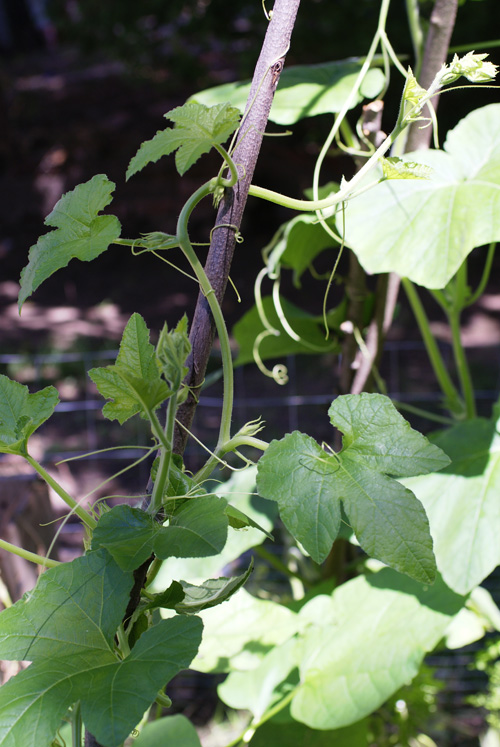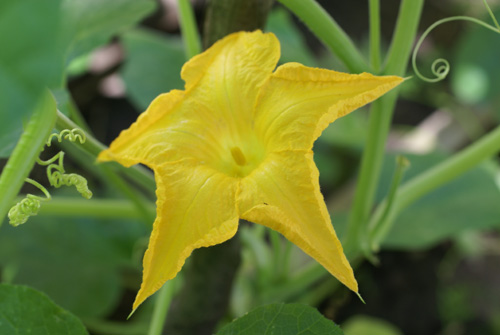Squash is one of the easiest and most productive garden plants one can grow. Even so, this king of the garden has some surprising features. For instance, did you know you can train squash to grow vertically to provide more space in the garden? Or that you can actually eat the squash blossoms? Did you know you can use milk to help keep a common squash problem under control? Read on for some more tips on growing and fun facts about everyone’s favorite garden crop.

Photo via Shutterstock/Shebeko
Did you know Craftsy now offers online gardening classes? Browse our growing selection of gardening classes, and be sure to also check out our first FREE gardening mini-class, Transform Your Garden Design for expert instructor on how to elevate your garden design with color, texture and form.
Planting
Squash is one of the oldest edible foods known to man, and gets its name from the Native American word askutasquash, meaning “eaten raw or uncooked.”
It can be grown in a variety of ways, including in rows, in hills, vertically oriented, or combined with companion plants. Native Americans used to grow squash as part of their three sisters garden, along with corn and beans. The beans would climb the corn and replenish the soil with nitrogen, and the squash would spread along the ground, holding moisture in the soil and keeping weeds at bay.
Plant squash in rich soil that drains quickly, well after the danger of frost has passed. Squash can be planted in rows or in hills and needs plenty of space to sprawl, so be sure to allow several feet for every plant. If you’re growing in a small garden, squash can be trained to grow vertically up a trellis. Sow six seeds per hill and thin to the two strongest seedlings when they germinate.

Care
If growing vertically, be sure to support heavy fruit so it doesn’t weigh down the plant or break off before it’s ripe. Scrap fabric or pantyhose can be tied onto the trellis to support the weight of the squash. If you didn’t go the vertical route, make sure to put down some sort of barrier between the squash and the ground to keep it from rotting. A wooden board or some mulch should do the trick.
If your soil isn’t the best, fertilize squash with a side dressing of compost or granular fertilizer a few times throughout the growing season.
Pests such as squash bugs and vine borers can ruin your whole squash crop if you’re not on the lookout for them. Squash bugs can be eliminated by hand picking and destroying, or in extreme cases, by using an insecticidal soap.
Another common problem with growing squash is powdery mildew. These white spots form when conditions are damp and shady, and if allowed to spread, will destroy your plants. Keep it at bay by spraying them several times a week with a mixture of one part milk to three parts water in a spray bottle.

Male and female squash flowers
Pollination
Pollination of squash isn’t usually a problem when insects or birds are around to help, but occasionally you’ll need to hand-pollinate to get a great harvest. Hand pollination is simple. You can differentiate male and female flowers by looking just underneath the bud, where it attaches to the stem. A female flower will have a tiny squash sitting right behind it, and a male flower won’t. Use a cotton swab or a paintbrush to transfer some of the pollen from the male flower to the female flower. You can even cut off a male flower and directly transfer the pollen to one or more female flowers.
Harvesting
For summer squash, pick the fruit before it ripens to encourage the plant to keep producing until fall. You’ll know the time is right when the blossoms fall off the end of the fruit. Winter squash needs to ripen on the vine, after the plant has died, but before the first big frost.

Eating
Those who grow summer squash such as zucchini know that it’s easy to get buried in the abundance of fruit from these productive plants. One zucchini plant can produce enough for one family at 6-10 pounds of fruit over the course of the season. Luckily, this versatile food can be cooked in a number of ways, baked, fried, roasted, even tossed into breads and cakes! Winter squash can be pureed and made into rich soups or pies. The possibilities are endless when it comes with creative uses for squash.
Did you know you can also eat the squash flowers? They’re delicious battered and fried, or stuffed with cheese and herbs. You can also bake them, or toss them into fresh pasta for a nice treat.
Like what you’ve read?
You might also enjoy our post on how to cook spaghetti squash and our butternut squash gnocchi recipe.

Share tips, start a discussion or ask one of our experts or other students a question.
No Responses to “Tips for Growing Squash + Some Surprising Fun Facts”